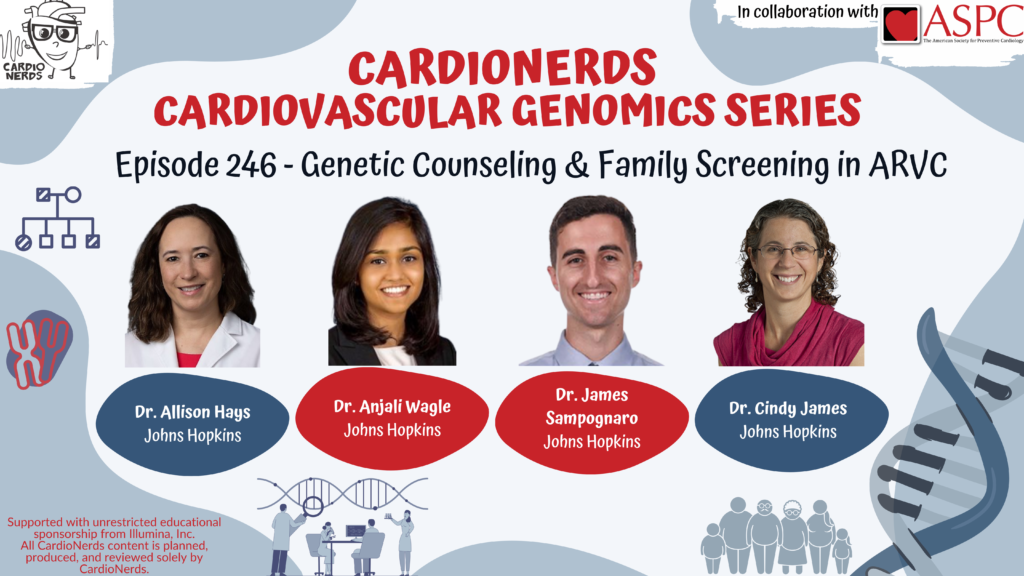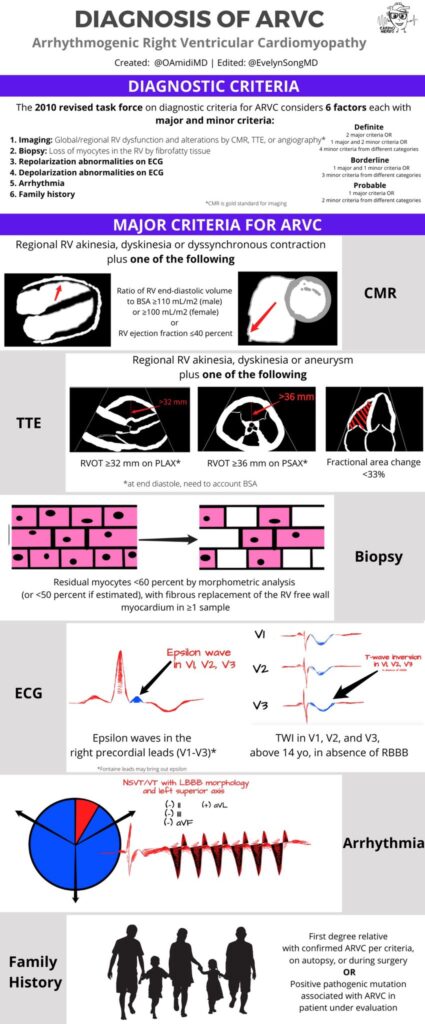Cardionerds: A Cardiology Podcast

246. Cardiovascular Genomics: Genetic Counseling & Family Screening in Arrhythmogenic Cardiomyopathies with Dr. Allison Hays and Dr. Cindy James
The CardioNerds Cardiovascular Genomics Series continues! In this episode Dr. Dan Ambinder (CardioNerds Cofounder and Interventional Cardiologist), Dr. Anjali Wagle (FIT Ambassador at Johns Hopkins) and Dr. James Sampognaro (medicine resident at Johns Hopkins Osler Medicine Residency) learn from Dr. Allison Hays (Associate Professor of Medicine, Division of Cardiology, Johns Hopkins CMR researcher and Medical Director of Echocardiography) and Dr. Cindy James (Associate Professor of Medicine and certified genetic counselor at Johns Hopkins with research focusing on cardiovascular genetic counseling and arrhythmogenic cardiomyopathies). They discuss arrhythmogenic RV cardiomyopathy as the context to learn about genetic counseling and family screening. Episode script and notes were developed by Dr. Anjali Wagle. Audio editing by CardioNerds Academy Intern, student doctor Chelsea Amo Tweneboah.
This episode was developed in collaboration with the American Society of Preventive Cardiology and is supported with unrestricted educational funds from Illumina, Inc. All CardioNerds content is planned, produced, and reviewed solely by CardioNerds.
This CardioNerds Cardiovascular Genomics series is a multi-institutional collaboration made possible by contributions of stellar fellow leads and expert faculty from several programs.
For related episodes, please enjoy these case-based discussions:
Pearls • Notes • References

CardioNerds Cardiovascular Genomics Page
CardioNerds Episode Page
CardioNerds Academy
Cardionerds Healy Honor Roll
CardioNerds Journal Club
Subscribe to The Heartbeat Newsletter!
Check out CardioNerds SWAG!
Become a CardioNerds Patron!
Show notes – Genetic Counseling & Family Screening in Arrhythmogenic Cardiomyopathies
Notes (developed by Dr. Anjali Wagle)
- What is the underlying pathophysiology of arrhythmogenic RV cardiomyopathy (ARVC)?
- Fibrofatty replacement cardiac myocytes
- Associated with genetically mediated disruption of desmosomal proteins
- This leads to thinning and weakness of the heart that can lead to aneurysms and progressive dilatation and failure of the right ventricle (RV)
- How is ARVC diagnosed?
- 2010 taskforce criteria (Marcus et al, 2010):
- RV structural abnormalities including findings seen on echocardiogram, MRI, and RV angiography
- Pathological criteria
- Repolarization abnormalities
- Depolarization/conduction abnormalities
- Ventricular arrhythmias
- Genetics and/or family history
- RV structural abnormalities including findings seen on echocardiogram, MRI, and RV angiography

- How does ARVC present?
- Young, healthy individual will have symptoms of arrhythmias (syncope, pre-syncope, SCD) or heart failure
- Family screening
- What are the inheritance and genetic factors of ARVC?
- Autosomal dominant pattern
- Low penetrance and variable expressivity
- Half of patients who are index cases will be found to have a mutation in the desmosomal gene.
- What are the most common mutations associated with ARVC?
- Most commonly the genes involved are plakophilin-2 (PKP-2) and desmoplakin.
- For PKP-2 the most common mutations are truncating mutations.
- In patients who have inherited two truncating mutations, this will result in neonatal lethality.
- Is there a difference in the genetic factors of left and right arrhythmogenic cardiomyopathy?
- ACM is disproportionally a right dominated cardiomyopathy. Left dominated cardiomyopathy has a different genetic profile.
- Pathogenic variants in desmoplakin disproportionally cause biventricular forms of ACM or left dominated forms.
- What are the echocardiographic findings in ACM?
- Wall thinning and aneurysmal dilation in the sub-tricuspid region, RV outflow tract, or base also known as the “triangle of dysplasia.”
- Progression of disease tends to be from the base to the apex.
- Why is cardiac MRI the preferred imaging modality in ACM?
- Higher spatial resolution and improved visualization of the right ventricle
- Can imaging help define prognosis in ACM?
- Top two strongest measures of prognostic value in ACM are:
- RV fractional change area < 33%
- Tricuspid annular plane systolic exertion < 1.7cm
- RV fractional change area < 33%
References – Genetic Counseling & Family Screening in Arrhythmogenic Cardiomyopathies






 Visit Podcast Website
Visit Podcast Website RSS Podcast Feed
RSS Podcast Feed Subscribe
Subscribe
 Add to MyCast
Add to MyCast